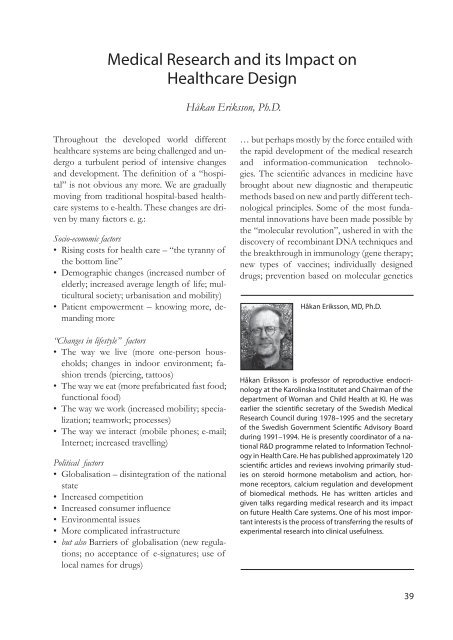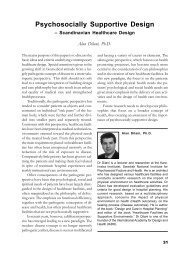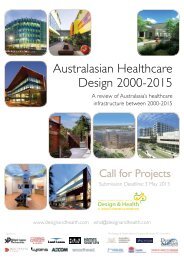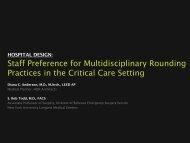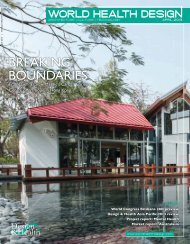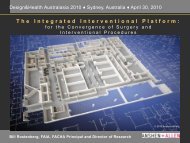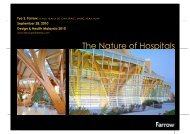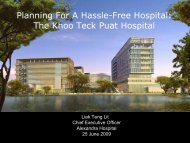Medical Research and its Impact on Healthcare Design - the ...
Medical Research and its Impact on Healthcare Design - the ...
Medical Research and its Impact on Healthcare Design - the ...
Create successful ePaper yourself
Turn your PDF publications into a flip-book with our unique Google optimized e-Paper software.
<str<strong>on</strong>g>Medical</str<strong>on</strong>g> <str<strong>on</strong>g>Research</str<strong>on</strong>g> <str<strong>on</strong>g>and</str<strong>on</strong>g> <str<strong>on</strong>g>its</str<strong>on</strong>g> <str<strong>on</strong>g>Impact</str<strong>on</strong>g> <strong>on</strong><strong>Healthcare</strong> <strong>Design</strong>Håkan Erikss<strong>on</strong>, Ph.D.Throughout <strong>the</strong> developed world differen<strong>the</strong>alth care systems are being challenged <str<strong>on</strong>g>and</str<strong>on</strong>g> undergoa turbulent period of intensive changes<str<strong>on</strong>g>and</str<strong>on</strong>g> development. The definiti<strong>on</strong> of a “hospital”is not obvious any more. We are graduallymoving from traditi<strong>on</strong>al hospital-based healthcaresystems to e-health. These changes are drivenby many factors e. g.:Socio-ec<strong>on</strong>omic factors• Rising costs for health care – “<strong>the</strong> tyranny of<strong>the</strong> bottom line”• Demographic changes (increased number ofelderly; increased average length of life; multiculturalsociety; urbanisati<strong>on</strong> <str<strong>on</strong>g>and</str<strong>on</strong>g> mobility)• Patient empowerment – knowing more, dem<str<strong>on</strong>g>and</str<strong>on</strong>g>ingmore“Changes in lifestyle” factors• The way we live (more <strong>on</strong>e-pers<strong>on</strong> households;changes in indoor envir<strong>on</strong>ment; fashi<strong>on</strong>trends (piercing, tattoos)• The way we eat (more prefabricated fast food;functi<strong>on</strong>al food)• The way we work (increased mobility; specializati<strong>on</strong>;teamwork; processes)• The way we interact (mobile ph<strong>on</strong>es; e-mail;Internet; increased travelling)Political factors• Globalisati<strong>on</strong> – disintegrati<strong>on</strong> of <strong>the</strong> nati<strong>on</strong>alstate• Increased competiti<strong>on</strong>• Increased c<strong>on</strong>sumer influence• Envir<strong>on</strong>mental issues• More complicated infrastructure• but also Barriers of globalisati<strong>on</strong> (new regulati<strong>on</strong>s;no acceptance of e-signatures; use oflocal names for drugs)… but perhaps mostly by <strong>the</strong> force entailed with<strong>the</strong> rapid development of <strong>the</strong> medical research<str<strong>on</strong>g>and</str<strong>on</strong>g> informati<strong>on</strong>-communicati<strong>on</strong> technologies.The scientific advances in medicine havebrought about new diagnostic <str<strong>on</strong>g>and</str<strong>on</strong>g> <strong>the</strong>rapeuticmethods based <strong>on</strong> new <str<strong>on</strong>g>and</str<strong>on</strong>g> partly different technologicalprinciples. Some of <strong>the</strong> most fundamentalinnovati<strong>on</strong>s have been made possible by<strong>the</strong> “molecular revoluti<strong>on</strong>”, ushered in with <strong>the</strong>discovery of recombinant DNA techniques <str<strong>on</strong>g>and</str<strong>on</strong>g><strong>the</strong> break through in immunology (gene <strong>the</strong>rapy;new types of vaccines; individually de signeddrugs; preventi<strong>on</strong> based <strong>on</strong> molecular geneticsHåkan Erikss<strong>on</strong>, MD, Ph.D.Håkan Erikss<strong>on</strong> is professor of reproductive en do crinologyat <strong>the</strong> Karolinska Institutet <str<strong>on</strong>g>and</str<strong>on</strong>g> Chair man of <strong>the</strong>department of Woman <str<strong>on</strong>g>and</str<strong>on</strong>g> Child Health at KI. He wasearlier <strong>the</strong> scien ti fic secretary of <strong>the</strong> Swedish <str<strong>on</strong>g>Medical</str<strong>on</strong>g>Re search Coun cil during 1978–1995 <str<strong>on</strong>g>and</str<strong>on</strong>g> <strong>the</strong> sec re taryof <strong>the</strong> Swedish Government Scientific Advisory Boardduring 1991–1994. He is pre sent ly coor dinator of a nati<strong>on</strong>alR&D programme related to Informati<strong>on</strong> Technologyin Health Care. He has published approximately 120scientific articles <str<strong>on</strong>g>and</str<strong>on</strong>g> reviews involving pri ma rily studies<strong>on</strong> ster oid horm<strong>on</strong>e me ta bo lism <str<strong>on</strong>g>and</str<strong>on</strong>g> acti<strong>on</strong>, horm<strong>on</strong>ereceptors, calcium regulati<strong>on</strong> <str<strong>on</strong>g>and</str<strong>on</strong>g> developmentof biomedical me thods. He has written articles <str<strong>on</strong>g>and</str<strong>on</strong>g>given talks regarding me di cal research <str<strong>on</strong>g>and</str<strong>on</strong>g> <str<strong>on</strong>g>its</str<strong>on</strong>g> impact<strong>on</strong> future Health Care systems. One of his most importantin te rests is <strong>the</strong> process of trans fe rr ing <strong>the</strong> results ofexperimental re search into clinical use ful ness.39
MEDICAL RESEARCH AND ITS IMPACT ON HEALTHCARE DESIGNfects. Some new methods based <strong>on</strong> cell biological<str<strong>on</strong>g>and</str<strong>on</strong>g> immunological basic science can alsobe expected to be used in clinical trials within aclose future.• Surgery. No decrease can be seen. The reas<strong>on</strong>sfor this is mainly that <strong>the</strong> large groupsof cancer in <strong>the</strong> ventricle, intestine <str<strong>on</strong>g>and</str<strong>on</strong>g> lungwill be treated similarly as 30 years ago <str<strong>on</strong>g>and</str<strong>on</strong>g> nosignificant <strong>the</strong>rapeutic progress is at sight.• Radiati<strong>on</strong>. A promising development of prot<strong>on</strong>-radiati<strong>on</strong><strong>the</strong>rapy is taking place.• Cytotoxic drugs. The research studying <strong>the</strong>cellular factors of importance for <strong>the</strong> sensitivityof <strong>the</strong> drug is progressing rapidly. The resultsof this will make it possible to individualise<strong>the</strong>rapy at different tumour c<strong>on</strong>diti<strong>on</strong>s,which will give better <strong>the</strong>rapeutic results <str<strong>on</strong>g>and</str<strong>on</strong>g>fewer side effects.• Antibody <strong>the</strong>rapy. The development of methodsto interfere with adhesi<strong>on</strong> molecules<strong>on</strong> <strong>the</strong> surface of <strong>the</strong> cancer cell will make itpossible to create drugs that will slow down<strong>the</strong> progress of metastasis.• Autologue <str<strong>on</strong>g>and</str<strong>on</strong>g> analogue b<strong>on</strong>e-marrow transplantati<strong>on</strong>.In combinati<strong>on</strong> with cytotoxicdrugs this technique will be used for treatmentof tumours which can’t be cured today,e.g. malignant melanomas <str<strong>on</strong>g>and</str<strong>on</strong>g> solid tumourssuch as cancer of <strong>the</strong> col<strong>on</strong> <str<strong>on</strong>g>and</str<strong>on</strong>g> breast cancer.• Gene <strong>the</strong>rapy. Large investments are made todevelop this technique for clinical purposes.It will be used <strong>on</strong> <strong>the</strong> <strong>on</strong>e h<str<strong>on</strong>g>and</str<strong>on</strong>g> to replacea defect gene which will cause cancer, <str<strong>on</strong>g>and</str<strong>on</strong>g><strong>on</strong> <strong>the</strong> o<strong>the</strong>r to modulate <strong>the</strong> expressing of<strong>on</strong>co-genes <str<strong>on</strong>g>and</str<strong>on</strong>g> supressor genes. The latterform of <strong>the</strong>rapy means a new strategy forcancer preventi<strong>on</strong> <str<strong>on</strong>g>and</str<strong>on</strong>g> treatment. Ano<strong>the</strong>rpromising form of <strong>the</strong>rapy involves blockingof <strong>the</strong> an gio genesis.• Substantial improvements in <strong>the</strong> <strong>the</strong>rapy ofdifferent forms of cancer in children; cancerin <strong>the</strong> lymphatic system, testis cancer <str<strong>on</strong>g>and</str<strong>on</strong>g> cancerof <strong>the</strong> urinary bladder.The new methods of tumour <strong>the</strong>rapy willin <strong>the</strong> future have a profound impact <strong>on</strong> <strong>the</strong>structural changes of <strong>the</strong> systems for <strong>the</strong> care<str<strong>on</strong>g>and</str<strong>on</strong>g> nursing of patients suffering from cancer.Therapy for diseases in <strong>the</strong> heart <str<strong>on</strong>g>and</str<strong>on</strong>g> bloodvesselsFundamental changes are taking place with regardto <strong>the</strong> treatment of different circulatorydisorders. The new <strong>the</strong>rapeutic methods willresult in fewer inpatients at <strong>the</strong> hospitals <str<strong>on</strong>g>and</str<strong>on</strong>g>a better quality of life for a larger number ofpatients. Some trends are summarised below.• Surgery of <strong>the</strong> heart <str<strong>on</strong>g>and</str<strong>on</strong>g> blood vessels. Newless invasive technologies are developed.The “BIG” open surgery in <strong>the</strong> thorax <str<strong>on</strong>g>and</str<strong>on</strong>g><strong>the</strong> brain will gradually be replaced by “ca<strong>the</strong>ter-based”techniques including PTCAin cor<strong>on</strong>ary vessels <str<strong>on</strong>g>and</str<strong>on</strong>g> introducti<strong>on</strong> of“stents” in narrow vessels.• Technologies for revascularisati<strong>on</strong> will beimproved (stents; ultrasound; laser, highspeeddrills). Also more serious damages of<strong>the</strong> vessel or l<strong>on</strong>g-lasting occlusi<strong>on</strong>s will betreatable. Transplantati<strong>on</strong> of endo<strong>the</strong>liumwill be used.• Treatment of heart failure. A rapid developmentof new types of drugs is taking place(e.g. ACE inhibitors; peptide horm<strong>on</strong>es).These new drugs will reduce <strong>the</strong> number ofin patients.• Treatment of stroke. The future will see less“classical” rehabilitati<strong>on</strong> <str<strong>on</strong>g>and</str<strong>on</strong>g> more early, aggressivetreatment with e.g. TPA <str<strong>on</strong>g>and</str<strong>on</strong>g> streptokinaseafter thrombosis <str<strong>on</strong>g>and</str<strong>on</strong>g> drugs thatprevent <strong>the</strong> progress <str<strong>on</strong>g>and</str<strong>on</strong>g> expansi<strong>on</strong> of <strong>the</strong>tissue damage after a haemorrhage. Acuteneuroprotective treatment will include <strong>the</strong>use of cal cium-channel antag<strong>on</strong>ists; GABAantag<strong>on</strong>ists <str<strong>on</strong>g>and</str<strong>on</strong>g> antag<strong>on</strong>ists against glutamate.• Methods to prol<strong>on</strong>g <strong>the</strong> survival time forcells that have been exposed to hypoxia in<strong>the</strong> brain or <strong>the</strong> myocardium will be develo-43
HEALTH MEDICAL FACILITY RESEARCH AND ITS IMPACT ON HEALTHCARE DESIGNped. This will create possibilities for rec<strong>on</strong>structivesurgery or o<strong>the</strong>r invasive techniquesto restore circulati<strong>on</strong> before <strong>the</strong> damage becomesirreversible.• Drugs with improved specificity <str<strong>on</strong>g>and</str<strong>on</strong>g> selectivity(receptor blockers) produced by biotechnologywill make it possible to more efficientlytreat several c<strong>on</strong>diti<strong>on</strong>s without anyside effects e.g. heart failure, arrhythmias, hypert<strong>on</strong>ia<str<strong>on</strong>g>and</str<strong>on</strong>g> hyperlipidaemia.Transplantati<strong>on</strong> as <strong>the</strong>rapeutic methodsThe immunological research has resulted in newdrugs which counteract <strong>the</strong> rejecti<strong>on</strong>/reacti<strong>on</strong>during transplantati<strong>on</strong>. Fur<strong>the</strong>rmore, it has createdc<strong>on</strong>diti<strong>on</strong>s which will make heterologousorgan transplantati<strong>on</strong> possible. Thus, <strong>the</strong> indicati<strong>on</strong>sfor organ transplantati<strong>on</strong> as a <strong>the</strong>rapeuticmethod will be broadened <str<strong>on</strong>g>and</str<strong>on</strong>g> <strong>the</strong> dem<str<strong>on</strong>g>and</str<strong>on</strong>g>sfor surgical <str<strong>on</strong>g>and</str<strong>on</strong>g> nursing capacity increased. Thepresent situati<strong>on</strong> can be summarised as follows:• Kidney, liver, heart, lungs <str<strong>on</strong>g>and</str<strong>on</strong>g> pancreas aretransplanted practically <strong>on</strong> a routine basis atdifferent centres specialising in transplantati<strong>on</strong>• Transplantati<strong>on</strong> of <strong>the</strong> intestine is still at aninitial stage• Great efforts are made to develop methodswhich will make it possible to use animalsas organ d<strong>on</strong>ors (xenotransplantati<strong>on</strong>), particularly<strong>the</strong> pig. Fur<strong>the</strong>rmore, extensiveresearch is carried out in order to solve <strong>the</strong>problems c<strong>on</strong>nected to <strong>the</strong> rejecti<strong>on</strong> of insulin-producingcells from pig pancreas.• Transplantati<strong>on</strong> of nerve cells (adrenal medullarcells <str<strong>on</strong>g>and</str<strong>on</strong>g> cells from brains of foetuses) isused in clinical trials to cure e. g. Parkins<strong>on</strong>s,Alzheimer, diabetes, epilepsy, damages of <strong>the</strong>spinal cord etc.Surgical <strong>the</strong>rapy – c<strong>on</strong>sequences of <strong>the</strong>scientific revoluti<strong>on</strong>• “Classical” general surgery (ventricle, gallbladder, intestines etc.) will decrease, partlybecause of <strong>the</strong> development of new drugs<str<strong>on</strong>g>and</str<strong>on</strong>g> partly because of <strong>the</strong> introducti<strong>on</strong> ofnew technologies (laparascopy). The remainingpart will primarily c<strong>on</strong>sist of cancer surgery,trauma surgery <str<strong>on</strong>g>and</str<strong>on</strong>g> rec<strong>on</strong>structive surgery.This will result in a reduced number ofin patients.• Emergency surgery will decrease <str<strong>on</strong>g>and</str<strong>on</strong>g> be c<strong>on</strong>centratedto fewer hospitals. This will mean<strong>the</strong> closing of smaller surgical clinics or turning<strong>the</strong>m into elective un<str<strong>on</strong>g>its</str<strong>on</strong>g>. Fewer <str<strong>on</strong>g>and</str<strong>on</strong>g> largerhigh-technology un<str<strong>on</strong>g>its</str<strong>on</strong>g> with high emergencycompetence will be formed. These structuralchanges will be most pr<strong>on</strong>ounced in <strong>the</strong>densely populated areas whereas <strong>the</strong> thinlypopulated areas will be changed less.• Orthopaedic surgery. This will increase becauseof <strong>the</strong> rapid development of new materialsfor pros<strong>the</strong>sis <str<strong>on</strong>g>and</str<strong>on</strong>g> new drugs, whichwill speed up <strong>the</strong> healing process of fractures<str<strong>on</strong>g>and</str<strong>on</strong>g> damages of <strong>the</strong> soft tissues. It is possiblethat cell transplantati<strong>on</strong> will be a new methodto treat damage of cartilage <str<strong>on</strong>g>and</str<strong>on</strong>g> b<strong>on</strong>e. Improvedmethods to prevent <str<strong>on</strong>g>and</str<strong>on</strong>g> treat osteoporosiswill be used.• Laparascopic surgery will be used <strong>on</strong> widenedindicati<strong>on</strong>s. The results of <strong>the</strong> methodwill be improved which will bring about amore extensive use of this technique.• Laser surgery will increase e.g. within gynaecology(early cancer in <strong>the</strong> cervix, vagina orlabia); urology (tumours of <strong>the</strong> urinary bladder,especially c<strong>on</strong>dyloma); otorhinolaryngology(cancer of <strong>the</strong> vocal cords <str<strong>on</strong>g>and</str<strong>on</strong>g> certaincases of cancer of <strong>the</strong> pharynx <str<strong>on</strong>g>and</str<strong>on</strong>g> larynx);<str<strong>on</strong>g>and</str<strong>on</strong>g> surgery of <strong>the</strong> cor<strong>on</strong>ary vessels.Therapy in psychiatric disordersC<strong>on</strong>cerning <strong>the</strong>rapy of psychiatric disorders<strong>the</strong> development is mostly c<strong>on</strong>centrated to a refinementof <strong>the</strong> psychopharmacological drugsthat are used today. Increased knowledge of <strong>the</strong>transmissi<strong>on</strong> systems in <strong>the</strong> brain <str<strong>on</strong>g>and</str<strong>on</strong>g> <strong>the</strong> mode44 (IADH) Internati<strong>on</strong>al Academy for <strong>Design</strong> <str<strong>on</strong>g>and</str<strong>on</strong>g> Health
MEDICAL RESEARCH AND ITS IMPACT ON HEALTHCARE DESIGNof acti<strong>on</strong> of different drugs will make it possibleto improve <strong>the</strong> <strong>the</strong>rapeutic precisi<strong>on</strong> <str<strong>on</strong>g>and</str<strong>on</strong>g>efficiency.• Selective drugs (serot<strong>on</strong>in inhibitors) withminimal side effects have been introduced<str<strong>on</strong>g>and</str<strong>on</strong>g> will be improved.• New drugs are being designed which will affect<strong>the</strong> serot<strong>on</strong>in system according to a differentmechanism of acti<strong>on</strong>. These drugs willalso be effective against so called “<strong>the</strong>rapyresistant”c<strong>on</strong>diti<strong>on</strong>s.• The mode of acti<strong>on</strong> of lithium will be solvedwhich will create a basis for <strong>the</strong> developmentof new substances with less toxicity.• Development of more selective drugs withfewer side effects for <strong>the</strong> treatment of schizophrenia.• New methods for <strong>the</strong> optimisati<strong>on</strong> of <strong>the</strong>dose of neuroleptica based <strong>on</strong> PET studiesof dopamine-receptor localisati<strong>on</strong>.• A breakthrough in <strong>the</strong> underst<str<strong>on</strong>g>and</str<strong>on</strong>g>ing of <strong>the</strong>pathogenesis of schizophrenia can be expected.Therapy in <strong>the</strong> future – some speculati<strong>on</strong>s• Producti<strong>on</strong> of new types of drugs <str<strong>on</strong>g>and</str<strong>on</strong>g> vaccinesusing biotechnology. E.g. TPA producedby biotechnological methods will be usedin treatment of thrombosis in <strong>the</strong> brain <str<strong>on</strong>g>and</str<strong>on</strong>g>heart (acute myocardial infarcti<strong>on</strong>) <str<strong>on</strong>g>and</str<strong>on</strong>g> erythropoietinat anaemia caused by renal disorders.The genes coding for most of <strong>the</strong>lymphocytes have been sequenced which willmake recombinant substances available for<strong>the</strong>rapeutic use.• Gene <strong>the</strong>rapy will be possible for m<strong>on</strong>ogeneticdiseases like Duchenne’s muscular dystrophy,using adenovirus vectors.• The etiological mechanisms behind <strong>the</strong> originof immunologicalinflammatory diseases likediabetes type 1, multiple sclerosis, rheumatoidarthritis will be solved <str<strong>on</strong>g>and</str<strong>on</strong>g> make preventi<strong>on</strong>possible.• HIV <str<strong>on</strong>g>and</str<strong>on</strong>g> AIDS treatment will be improvedby <strong>the</strong> introducti<strong>on</strong> of new drugs. It is howeverdoubtful whe<strong>the</strong>r it will be possible tocreate a vaccine against HIV.• Vaccines against malaria, cholera <str<strong>on</strong>g>and</str<strong>on</strong>g> ordinarycold will be developed.<strong>Healthcare</strong> developmentThe development in <strong>the</strong> healthcare organisati<strong>on</strong>is directed towards a process-oriented systemwhich h<strong>on</strong>our keywords such as “patient orientati<strong>on</strong>”,“knowledge navigati<strong>on</strong>”, “coordinati<strong>on</strong>/feedback”<str<strong>on</strong>g>and</str<strong>on</strong>g> “benchmarking” <str<strong>on</strong>g>and</str<strong>on</strong>g> whichforms a logistic chain from “Social security system”– “Pre venti<strong>on</strong> care” – “Primary medicalcare” – “Diag nostics” – “Therapeutics” – Rehabilita ti<strong>on</strong>” – “Work/retirement” to “Follow-upmeasures” <str<strong>on</strong>g>and</str<strong>on</strong>g> includes patient-centred hospitals.The evoluti<strong>on</strong> can be illustrated as followsTodayFragmented servicesTreating illnessesAcute, inpatient careInstituti<strong>on</strong>al measuresPerceived qualityIndividual IT systemsTomorrowC<strong>on</strong>tinuum of careManaging healthPreventive/primarycareCommunity measuresOutcome measures,report cardsIntegrated IT networksThis shift will most likely lead to a partial disintegrati<strong>on</strong>of <strong>the</strong> omnipotent “Mega-instituti<strong>on</strong>s”,which try to cover everything in <strong>the</strong> medicalarea, <str<strong>on</strong>g>and</str<strong>on</strong>g> <strong>the</strong> formati<strong>on</strong> of smaller customized<str<strong>on</strong>g>and</str<strong>on</strong>g> specialized un<str<strong>on</strong>g>its</str<strong>on</strong>g> which will collaborate inan integrated network, much based <strong>on</strong> moderninformati<strong>on</strong>-communicati<strong>on</strong> technologies. Thehealth care system will gradually move from an“informati<strong>on</strong> hierarchy” to an “informati<strong>on</strong>hyperarchy”. We will see <strong>the</strong> development ofa health network which integrates <strong>the</strong> informati<strong>on</strong>flow related to <strong>the</strong> individual patient in <strong>the</strong>following way.In this way it will be possible to integrate <strong>the</strong>45
HEALTH MEDICAL FACILITY RESEARCH AND ITS IMPACT ON HEALTH CARE DESIGN<strong>Healthcare</strong> system <str<strong>on</strong>g>and</str<strong>on</strong>g> informati<strong>on</strong> technology.different comp<strong>on</strong>ents of <strong>the</strong> healthcare systemfrom a patient perspective i.e.• Rapid <str<strong>on</strong>g>and</str<strong>on</strong>g> easy access to primary care• Services close to home• Access to specialist c<strong>on</strong>sultants• <str<strong>on</strong>g>Medical</str<strong>on</strong>g> records available at point of service• Collaborati<strong>on</strong> <str<strong>on</strong>g>and</str<strong>on</strong>g> c<strong>on</strong>sultati<strong>on</strong> am<strong>on</strong>g careproviders• Coordinati<strong>on</strong> of care• Clinical process improvement• C<strong>on</strong>tinuous quality assessment of care• Easy access to medical informati<strong>on</strong>.Since <strong>the</strong>se changes will have a fundamentalimpact <strong>on</strong> <strong>the</strong> way healthcare professi<strong>on</strong>als willwork toge<strong>the</strong>r <str<strong>on</strong>g>and</str<strong>on</strong>g> with <strong>the</strong> patient, <strong>the</strong>y willalso str<strong>on</strong>gly influence <strong>the</strong> dem<str<strong>on</strong>g>and</str<strong>on</strong>g>s <strong>on</strong> <strong>the</strong> architecturaldesign of hospitals. Several serviceun<str<strong>on</strong>g>its</str<strong>on</strong>g> which today c<strong>on</strong>stitute physical parts of<strong>the</strong> hospi tal building will in <strong>the</strong> future be localizedoutside <strong>the</strong> hospital <str<strong>on</strong>g>and</str<strong>on</strong>g> instead be accessedvia IT networks. The figure below illustrates aposs ible future scenario in a hospital ward.All informati<strong>on</strong> regarding each individualpatient can displayed <strong>on</strong> a “patient navigator”c<strong>on</strong>nected to a wireless bedside informati<strong>on</strong>system which can access databases in differentservice disci plines such as clinical physiology,laboratory medicine, image-processing center<str<strong>on</strong>g>and</str<strong>on</strong>g> pharmacy. Fur<strong>the</strong>rmore, <strong>the</strong> doctor canc<strong>on</strong>sult both specialists via telemedicine <str<strong>on</strong>g>and</str<strong>on</strong>g>external health-status assessment databases<strong>on</strong>line. After examinati<strong>on</strong> of <str<strong>on</strong>g>and</str<strong>on</strong>g> c<strong>on</strong>versati<strong>on</strong>with <strong>the</strong> patient, all anamnestic statements, ordereddiagnostic tests <str<strong>on</strong>g>and</str<strong>on</strong>g> prescribed drugs arerecorded in <strong>the</strong> patient’s electr<strong>on</strong>ic record in <strong>the</strong>central medical record data base via <strong>the</strong> patientnavigator. This database can <strong>the</strong>n be accessedby duly qualified pers<strong>on</strong>nel in e.g. <strong>the</strong> primarycare center to which <strong>the</strong> patient is affiliated.Thus <strong>the</strong> prerequisites for a development of“patient-centred care” are here <str<strong>on</strong>g>and</str<strong>on</strong>g> several keyfactors drive this evoluti<strong>on</strong>.46 (IADH) Internati<strong>on</strong>al Academy for <strong>Design</strong> <str<strong>on</strong>g>and</str<strong>on</strong>g> Health
MEDICAL RESEARCH AND ITS IMPACT ON HEALTHCARE DESIGNClinical physiologycenterImage-processingcenterLaboratorycenterPatient navigatorHealth-statusassessmentEBM databaseWireless bedsidesystemPharmacyC<strong>on</strong>sultantspecialistElectr<strong>on</strong>ic medical recordTelemedicinec<strong>on</strong>sultantAll informati<strong>on</strong> regarding each patient could displayed <strong>on</strong> a patientnavigator.• The underst<str<strong>on</strong>g>and</str<strong>on</strong>g>ing of genetic predispositi<strong>on</strong>.This will make it possible to predict healthrisks for individuals by establishing links betweendefect genes <str<strong>on</strong>g>and</str<strong>on</strong>g> specific diseases. Fur<strong>the</strong>rmore it will serve as <strong>the</strong> basis for individualizeddrug treatment.• More readily available informati<strong>on</strong>. Through<strong>the</strong> Internet a whole new world of “Healthportals” will be accessible. These will be anythingfrom general health sites with medical<str<strong>on</strong>g>and</str<strong>on</strong>g> health news to highly specialized diseasespecific sites aiming at selective groups of patients.• More active <str<strong>on</strong>g>and</str<strong>on</strong>g> informed c<strong>on</strong>sumers. Thepatient educates her-/himself via chat groups<str<strong>on</strong>g>and</str<strong>on</strong>g> active patient groups <strong>on</strong> <strong>the</strong> Internet <str<strong>on</strong>g>and</str<strong>on</strong>g>via high-quality TV producti<strong>on</strong> in specificeducati<strong>on</strong>al channels.• Increasing resp<strong>on</strong>sibility of c<strong>on</strong>sumers. Thepatient will take active part in <strong>the</strong> diagnosticprocess e.g. by using “home diagnostics”.Visi<strong>on</strong>s of <strong>the</strong> future for <strong>the</strong> structure of <strong>the</strong>healthcare systemIn a shorter perspective than 5 years it is not likelythat <strong>the</strong> medical research <str<strong>on</strong>g>and</str<strong>on</strong>g> developmentwill have any greater impact <strong>on</strong> <strong>the</strong> structure <str<strong>on</strong>g>and</str<strong>on</strong>g>functi<strong>on</strong> of hospitals <str<strong>on</strong>g>and</str<strong>on</strong>g> <strong>the</strong> health-care systemthan <strong>the</strong> <strong>on</strong>e which is <strong>the</strong> result of already partlyimplemented, established new technologies asdescribed above. The fast development in preventi<strong>on</strong>,diagnostics, <strong>the</strong>rapeutics <str<strong>on</strong>g>and</str<strong>on</strong>g> communicati<strong>on</strong>technologies will, however, create c<strong>on</strong>diti<strong>on</strong>sfor a society where most of <strong>the</strong> healthcarecan be h<str<strong>on</strong>g>and</str<strong>on</strong>g>led locally <str<strong>on</strong>g>and</str<strong>on</strong>g> close to <strong>the</strong> patientregardless where you live. The need for largehospitals will be reduced. The “hospital-free”society is coming closer. To bring this visi<strong>on</strong>a step fur<strong>the</strong>r let us first look <strong>on</strong> <strong>the</strong> presentstructure of <strong>the</strong> Swedish healthcare system. Inthat you can identify five distinct organisati<strong>on</strong>allevels. Three of <strong>the</strong>se levels include different-sizedhospitals, each with <str<strong>on</strong>g>its</str<strong>on</strong>g> own emergency ward<str<strong>on</strong>g>and</str<strong>on</strong>g> surgical department, which h<str<strong>on</strong>g>and</str<strong>on</strong>g>les similar47
HEALTH MEDICAL FACILITY RESEARCH AND ITS IMPACT ON HEALTHCARE DESIGNtypes of medical disorders. This means e.g. thatsmall numbers of difficult <str<strong>on</strong>g>and</str<strong>on</strong>g> advanced surgicaloperati<strong>on</strong>s are performed at a large numberof smaller hospitals <strong>on</strong> <strong>the</strong> municipal level bysurge<strong>on</strong>s with limited experience of that kindof surgery <str<strong>on</strong>g>and</str<strong>on</strong>g> that high-technology diagnostic<str<strong>on</strong>g>and</str<strong>on</strong>g> <strong>the</strong>rapeutic techniques are introduced athigh costs in hospitals where <strong>the</strong>y will be usedrarely by inexperienced pers<strong>on</strong>al.In order to get a high quality in <strong>the</strong> utilisati<strong>on</strong>of <strong>the</strong>se new <str<strong>on</strong>g>and</str<strong>on</strong>g> advanced technologies<strong>the</strong>y must be c<strong>on</strong>centrated to larger centres ofexperts at <strong>the</strong> regi<strong>on</strong>al-/university-hospital level,where a large number of diagnostic examinati<strong>on</strong>sare performed <str<strong>on</strong>g>and</str<strong>on</strong>g> where R&D is a partof <strong>the</strong> daily use of <strong>the</strong>se technologies. To <strong>the</strong>seexpert centres are c<strong>on</strong>centrated diagnostic techniquesrequiring heavy, expensive high-technologyequipment <str<strong>on</strong>g>and</str<strong>on</strong>g> a cadre of specially-trainedphysicians <str<strong>on</strong>g>and</str<strong>on</strong>g> nurses <str<strong>on</strong>g>and</str<strong>on</strong>g> <strong>the</strong>rapeutic methodsinvolving large, complicated operati<strong>on</strong>s <str<strong>on</strong>g>and</str<strong>on</strong>g>“aggressive” treatments. Since <strong>the</strong> classical borderlinesbetween different diagnostic laboratorydisciplines are gradually being more <str<strong>on</strong>g>and</str<strong>on</strong>g> moreunsharp, c<strong>on</strong>diti<strong>on</strong>s are created for diagnosticcentres where radiology, clinical chemistry, histopathology,clinical physiology <str<strong>on</strong>g>and</str<strong>on</strong>g> clinical microbiologycan be integrated. These hospitalsshould in turn serve as nodes in an integratednetwork of different hospitals, primary- carecentres <str<strong>on</strong>g>and</str<strong>on</strong>g> nursing instituti<strong>on</strong>s which are localisedclose to <strong>the</strong> patients as outlined in <strong>the</strong> figurebelow.By doing this problems with investments innew expensive equipment <str<strong>on</strong>g>and</str<strong>on</strong>g> pers<strong>on</strong>al competence,can be h<str<strong>on</strong>g>and</str<strong>on</strong>g>led in a more cost-effectiveway.The new possibilities to transfer largeamounts of qualified informati<strong>on</strong> over l<strong>on</strong>gdistances <str<strong>on</strong>g>and</str<strong>on</strong>g> analyse <str<strong>on</strong>g>and</str<strong>on</strong>g> store it <strong>on</strong> o<strong>the</strong>r placesthan where it was generated will have a greatimpact <strong>on</strong> <strong>the</strong> future structure of <strong>the</strong> healthcareorganisati<strong>on</strong>, since it will make it possibleto move <strong>the</strong> desirable diagnostic <str<strong>on</strong>g>and</str<strong>on</strong>g> <strong>the</strong>rapeuticcompetence to <strong>the</strong> patient instead of viceversa.C<strong>on</strong>clusi<strong>on</strong>sThus, <strong>the</strong> scientific achievements in medicine<str<strong>on</strong>g>and</str<strong>on</strong>g> informati<strong>on</strong> technologies have created c<strong>on</strong>diti<strong>on</strong>sfor a new healthcare structure with:48 (IADH) Internati<strong>on</strong>al Academy for <strong>Design</strong> <str<strong>on</strong>g>and</str<strong>on</strong>g> Health


